Clarifier / Lamella Tube Settlers / Lamella Clarifiers / Tilted Plate Separator


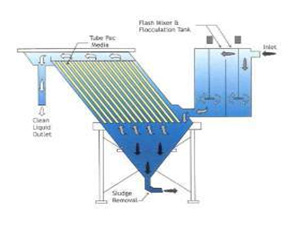
A clarifier is a water treatment process that features a rack of inclined metal plates, which cause flocculated material to precipitate from water that flows across the plates. In this the solids are separated from the liquids in effluent stream.
Effluent enters the lamella clarifier (Compact Clarifier) where it is usually flash mixed with a polymer flocculant and then gently agitated with a separate mixer. Conventional clarification equipment requires a much larger surface footprint in order to match the solids removal capacity of a lamella clarifierR. This is accomplished because the effective gravity settling area of the inclined plate design is proportional to the total surface area of the inclined plate rack.
Clariflocculators are generally used for chemical primary treatment for effluent. Instead of separate flocculation & clarification, clariflocculators are generally used. This results into economical and faster installation of primary treatment.
Reaction Clarifiers / Solid Contact Clarifiers

The solids contact clarifier employs a recycle solids contact principal for flocculation, sedimentation, and clarification in a single basin. The system features a concentric drive unit and mixer combination. The slow speed impeller recirculates fresh precipitate through the recirculation drum. The formulation of settleable floc particles occurs in the mixing reaction cone. An automatic sludge discharge system maintains the solids volume along the clarifier bottom. Solids contact units are used for the removal of turbidity for lime softening, and for chemical coagulation in municipal and industrial applications.
Aerators (Fixed, floating) and Diffusers

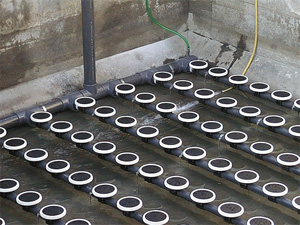
Diffuser is an aeration device typically in the shape of a disc, tube or plate, which is used to transfer air and with that oxygen into sewage or industrial wastewater. Oxygen is required by microorganisms/bacteria residents in the water to break down the pollutants. Diffusers use either rubber membranes or ceramic elements typically and produce either fine or coarse bubbles.
Tilted Plate Interceptor (TPI)/ Corrugated Plate Interceptor (CPI)


Corrugated Plate Separators (CPS) provide economical and effective removal of oil and solids from wastewater by gravity, in a smooth, efficient automatic flow. In the CPI velocity is slowed and the flow is directed into the quiescent zone. Gross, free oil droplets rise, and the flow containing residual small free droplets and solids particles enters the CPI in a laminar flow condition. series of parallel plates, arranged to allow small, free oil droplets to coalesce and separate from the carrier fluid. Separation is based on the differences in the specific gravities of the fluids and the liquid temperature Separated oil rises to the peaks of the corrugations in the parallel plates. At the top of the unit, the separated oil forms a layer and is skimmed by an adjustable trough or weir.
Dissolved Air Floatation Unit (DAF)
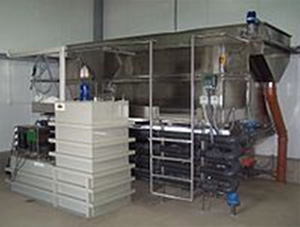
In this treatment process that clarifies wastewaters (or other waters) by the removal of suspended matter such as oil or solids. The removal is achieved by dissolving air in the water or wastewater under pressure and then releasing the air at atmospheric pressure in a flotation tank or basin. The released air forms tiny bubbles which adhere to the suspended matter causing the suspended matter to float to the surface of the water where it may then be removed by a skimming device.
Tilted Plate Interceptor (TPI)/ Corrugated Plate Interceptor (CPI)

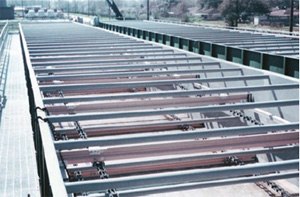
An API oil-water separator is a device designed to separate gross amounts of oil and suspended solids from the wastewater effluents of oil refineries, petrochemical plants, chemical plants, natural gas processing plants and other industrial sources.
The API separator is a gravity separation device designed by using Stokes Law to define the rise velocity of oil droplets based on their density and size. The design of the separator is based on the specific gravity difference between the oil and the wastewater because that difference is much smaller than the specific gravity difference between the suspended solids and water. Based on that design criterion, most of the suspended solids will settle to the bottom of the separator as a sediment layer, the oil will rise to top of the separator, and the wastewater will be the middle layer between the oil on top and the solids on the bottom.[2]
Typically, the oil layer is skimmed off and subsequently re-processed or disposed of, and the bottom sediment layer is removed by a chain and flight scraper (or similar device) and a sludge pump. The water layer is sent to further treatment consisting usually of a dissolved air flotation (DAF) unit for further removal of any residual oil and then to some type of biological treatment unit for removal of undesirable dissolved chemical compounds.
Oil skimmers (all types)
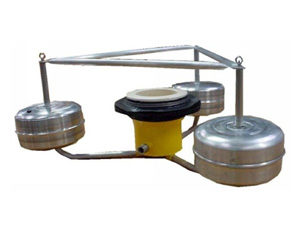

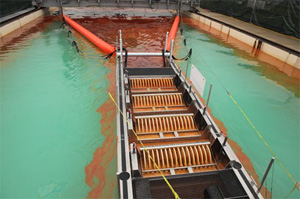
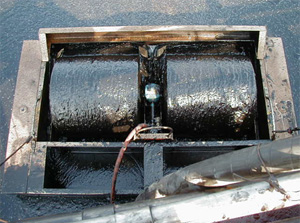
An oil skimmer is a machine that separates a liquid from particles floating on it or from another liquid. A common application is removing oil floating on water. These technologies are commonly used for oil spill remediation but are also commonly found in industry. Oil skimmers are commonly found in three types: weir, oleophilic, and drum.
Weir skimmers
Weir skimmers function by allowing the oil floating on the surface of the water to flow over a weir. The height of the weir may be adjustable. These devices will collect water when oil is no longer present. Weir skimmers are also available in floating, self-adjusting variations. These models allow them to be effectively used even in changing water levels.
Oleophilic skimmers
They are distinguished not by their operation but by the component used to collect the oil. Ropes, discs, or drums are treated with a substance or otherwise manufactured to adhere to oil.
Drum skimmers
They function by using a rotating element such as a drum, to which the oil adheres. The oil is wiped from the surface of the drum and collected. They are very efficient and do not pick up any appreciable amounts of water even when oil is not present.
Pressure Sand / Activated Carbon/ Dual Media Filters
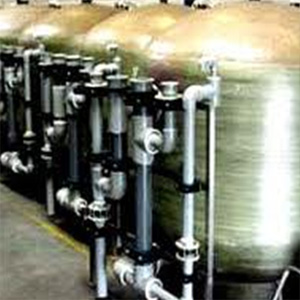
Dual media filter contain combination of Sand & Carbon filter. It is generally used for polishing of the water as per the end use of the effluent. Generally filters are used to remove humidity of the turbidity and organics, dechlorination, etc. Such type of filters are very compact in size.
Vacuum Drum Filters
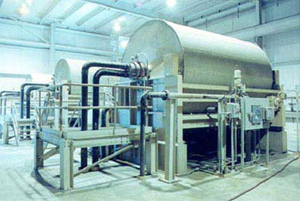

Rotary vacuum filter drum consists of a drum rotating in a tub of liquid to be filtered. The technique is well suited to high solids liquids that would blind or block other forms of filter. The drum rotates through the liquid and the vacuum sucks liquid and solids onto the drum pre-coat surface, the liquid portion is “sucked” by the vacuum through the filter media to the internal portion of the drum, and the filtrate pumped away. The solids adhere to the outside of the drum, which then passes a knife, cutting off the solids and a small portion of the filter media to reveal a fresh media surface that will enter the liquid as the drum rotates. The knife advances automatically as the surface is removed.
